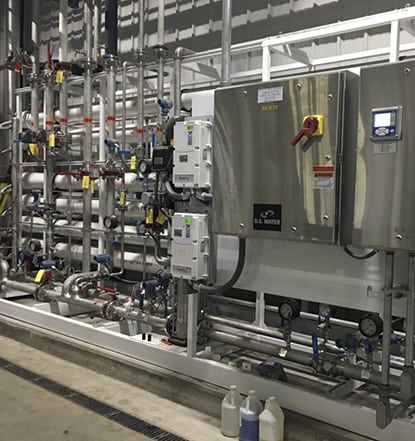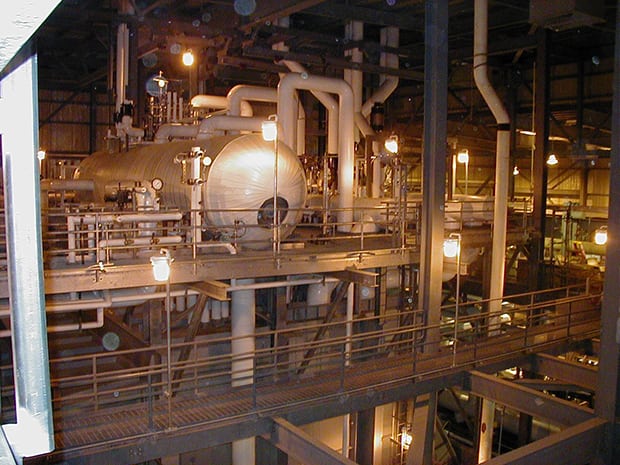Select Boiler Chemistry in the Design Phase of Project Life
On many combined cycle projects, the major decisions about boiler chemistry are left until after the plant has been designed, equipment is procured, and construction is well underway. However, the best time to make these chemistry decisions is in the design phase of the project. That enables the engineering, procurement, and construction (EPC) contractor to design the plant that best fits the selected chemistry program (Figure 1).
 |
1. Water treatment decisions. The EPC contractors should design the plant that best fits the users’ selected chemistry program. Courtesy: Colleen Scholl, HDR Inc. |
Phosphate Versus Oxidizing, All-Volatile Treatment
For example, consider the selection of a phosphate program versus an oxidizing, all-volatile treatment (AVT-O) program. Of these two, the phosphate program requires more-responsive instrumentation and controls, because of the potential problems of phosphate carryover and hideout. If the EPC contractor has a priori knowledge that phosphates will be used, its engineers can specify highly responsive pH and phosphate instruments, and can ensure those instrument signals are transmitted to automated chemical-injection pumps that feed into multiple injection points (Figure 2).
 |
2. Designed for success. A phosphate program can be optimized by designing the system with multiple chemical-injection points. Courtesy: Colleen Scholl, HDR Inc. |
An automated, multi-injection design such as this would deliver more-consistent and more-accurate chemistry control compared to a typical combined cycle design, which often has a single chemical-injection point located at the condensate pump discharge or downstream of a condensate polisher. A priori knowledge that phosphates will be used also enables engineers to design a blowdown system that fully complies with phosphorus limits in the project’s liquid-discharge permit.
If the AVT-O program is selected instead of phosphates, then the EPC contractor would be able to design the best scheme for handling upset conditions. That scheme might include the installation of a condensate polisher or an emergency/backup phosphate-injection point for corrosion protection during upsets (Figure 3).
 |
3. Getting it right. An AVT-O program is optimized if the EPC specifies fixed water-treatment equipment to handle upsets. Courtesy: Colleen Scholl, HDR Inc. |
Cation Conductivity
Another heat recovery steam generator (HRSG) chemistry decision that’s best made in the design phase is how best to meet the steam turbine original equipment manufacturer’s (OEM’s) limit on cation conductivity. Also referred to as “conductivity after cation exchange” (CACE) or “acid conductivity,” the cation conductivity is measured in units of micro-Siemens per centimeter, and the OEM’s limit may be difficult to meet—sometimes so difficult that it delays the first roll of the turbine and commissioning of new projects.
The best way to avoid this delay is to start with the OEM limits and calculate backwards to establish the appropriate limits for each of the steam-cycle systems—one for the feedwater, one for the condensate, and so on. Some HRSG-chemistry options might get ruled out simply by reviewing the steam-turbine OEM limit and doing the math. For instance, an amine program injects organic compounds that decompose, adding cation conductivity to the steam, thus affecting design decisions. Engineers with a priori knowledge of amine usage can strategically locate the amine-injection point to meet the OEM limit while still providing the amine dosage needed for corrosion protection of metal surfaces.
Film-Forming Amines
Yet another chemistry decision that’s best made in the design phase is the selection of film-forming amines (FFAs). In contrast to older, neutralizing amines, which provide corrosion protection via pH elevation and the formation of a protective iron-oxide surface layer, these newer FFAs actually produce a physical barrier—the “film” in the name—to protect against both the oxygen and carbon dioxide types of corrosion.
Early experience in HRSGs shows that FFAs are quite effective, but one downside is they have limited volatility (meaning they tend to stay in the liquid form and aren’t carried out of the HRSG into the downstream steam piping). So, for HRSG users to maximize the benefits of FFAs, the EPC contractor must design an FFA injection point that adds directly into the steam header instead of the customary injection point into the condensate header.
Boiler Chemistry
Battling corrosion in a steam plant can be a tiring and frustrating job because even the best HRSG-chemistry program doesn’t guarantee corrosion protection. But a bad HRSG-chemistry program does promise heaps of corrosion!
This article is based on “The Future of HRSG O & M, Design, Commissioning, and New Projects,” a workshop conducted by the HRSG User’s Group on February 12, 2018.
—Rob Swanekamp is executive director of HRSG User’s Group Inc. and Coleen Scholl, PE is the manager of HDR Inc.’s power-water practice.